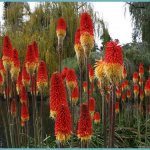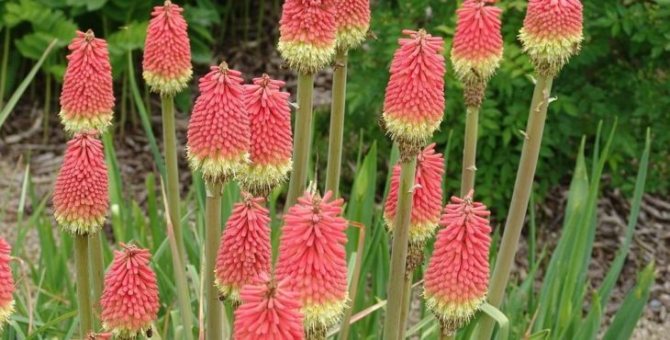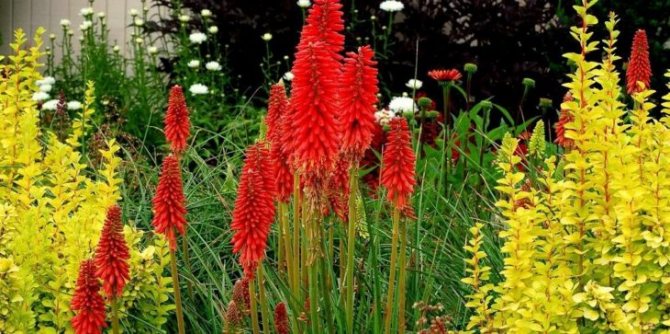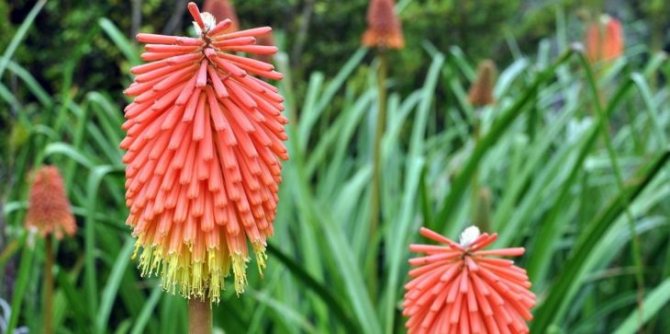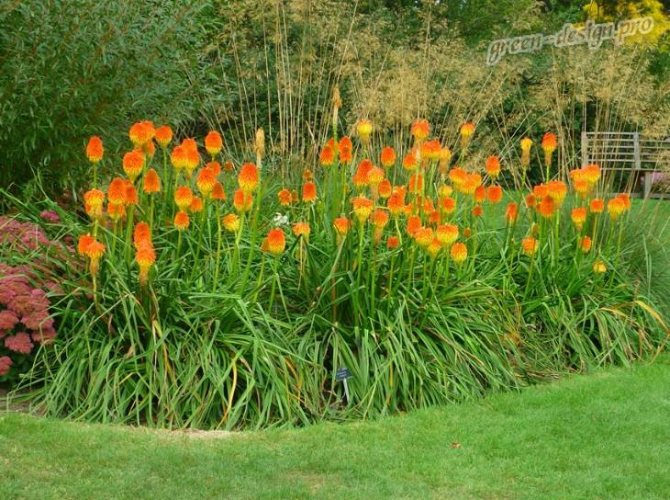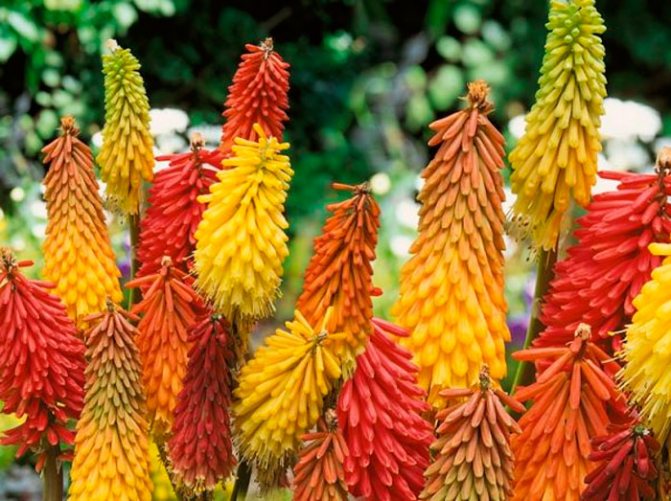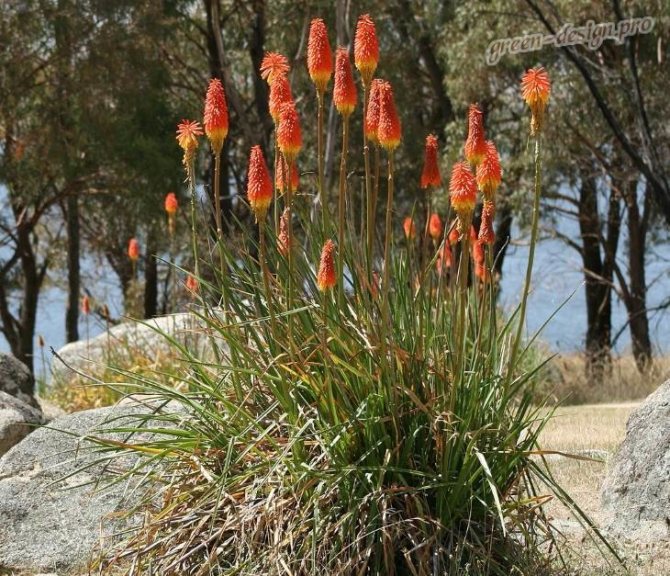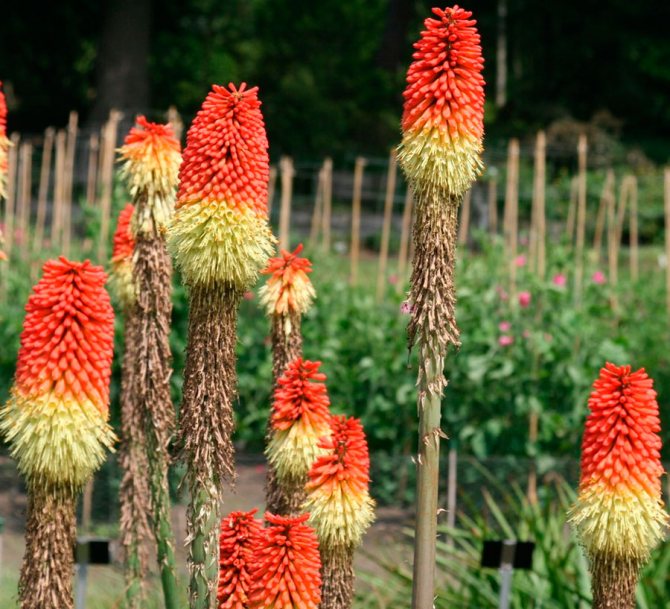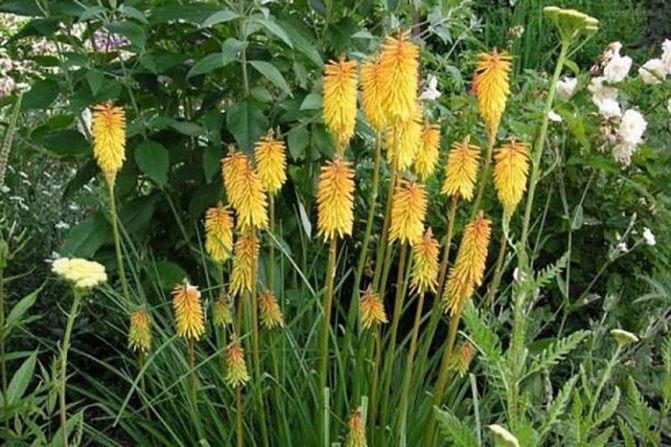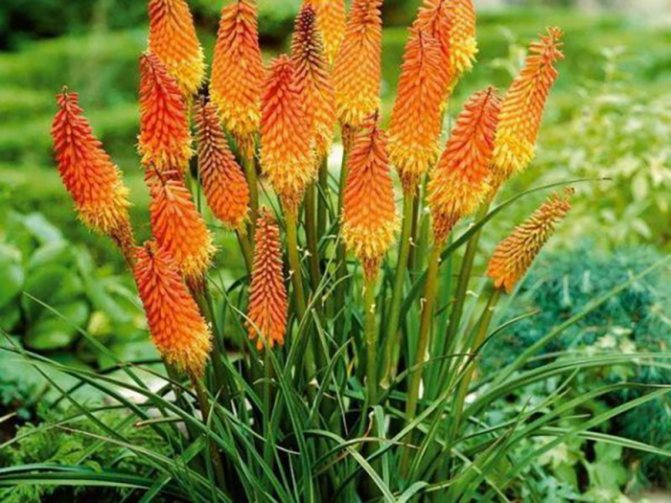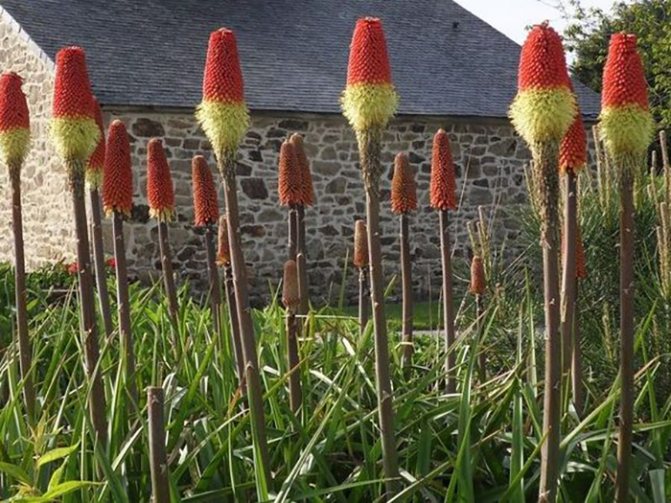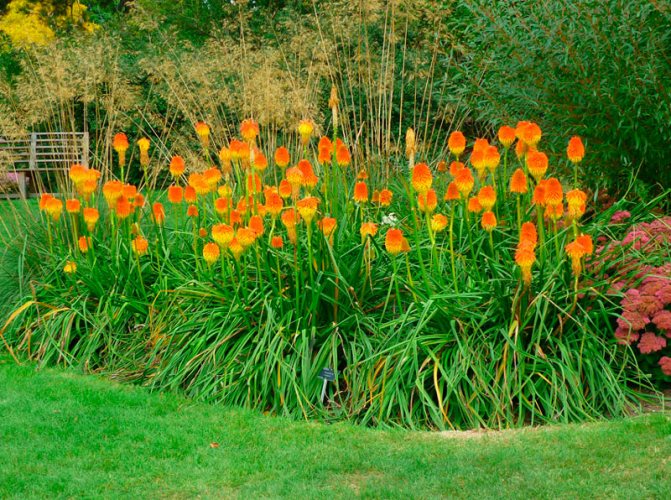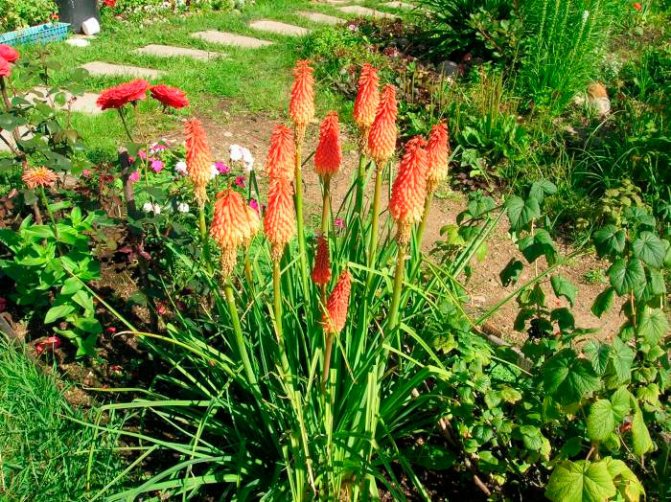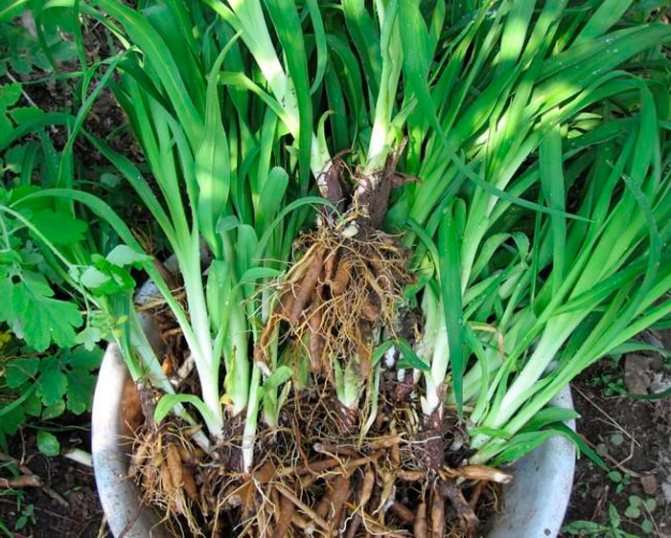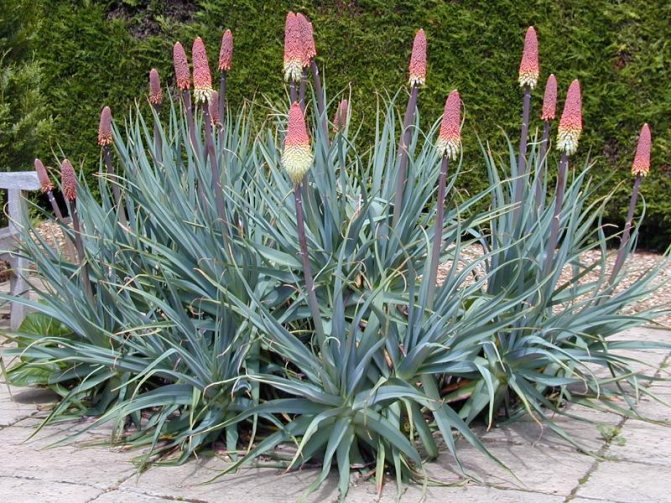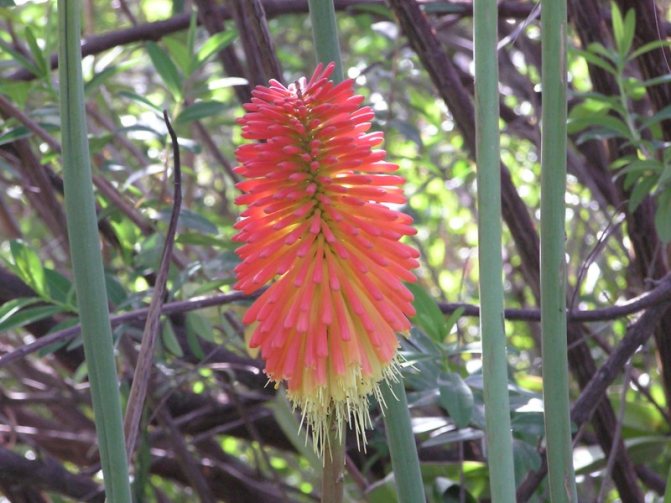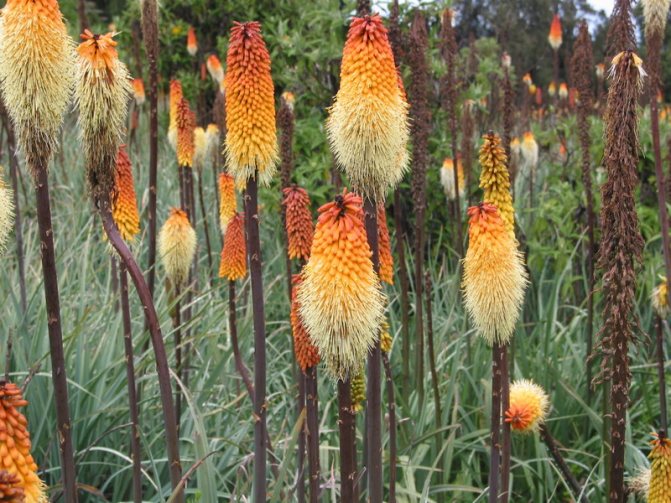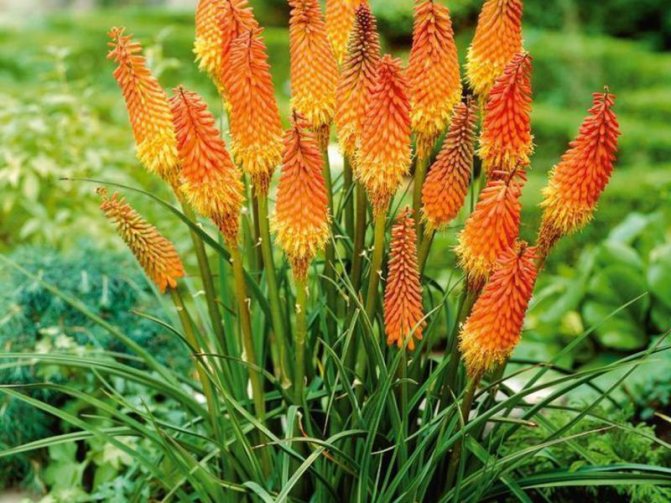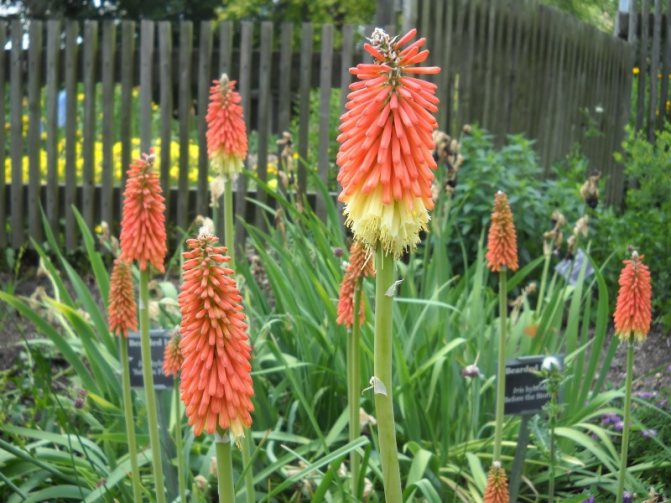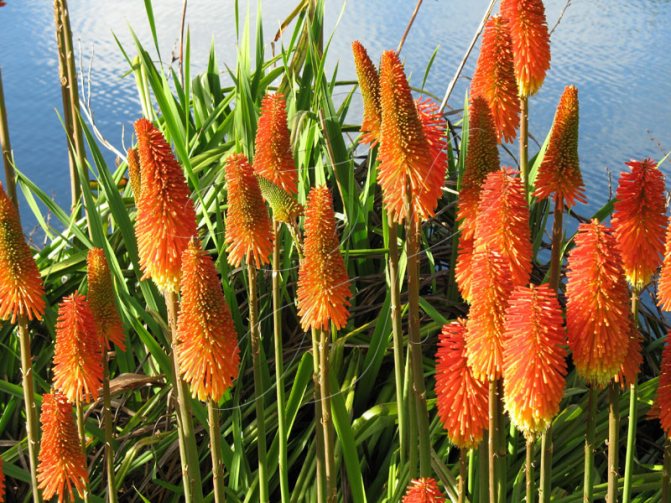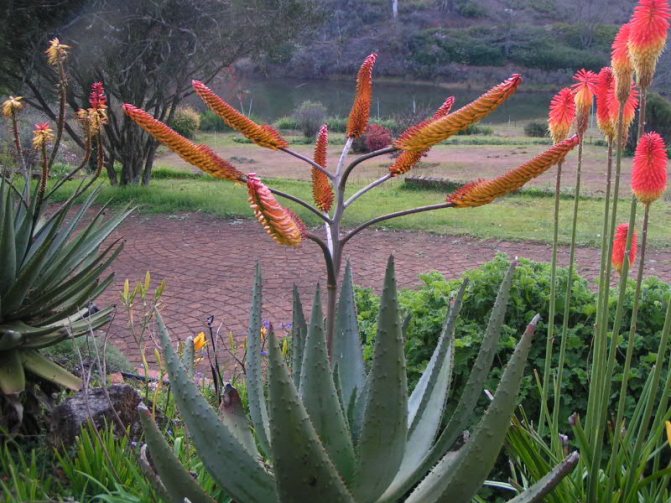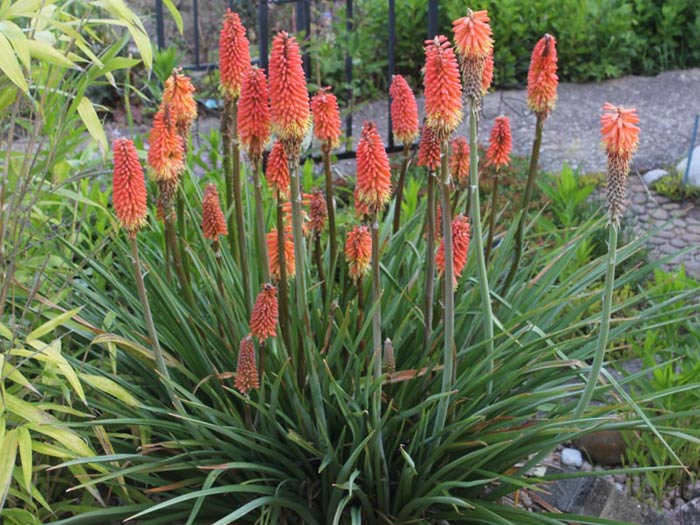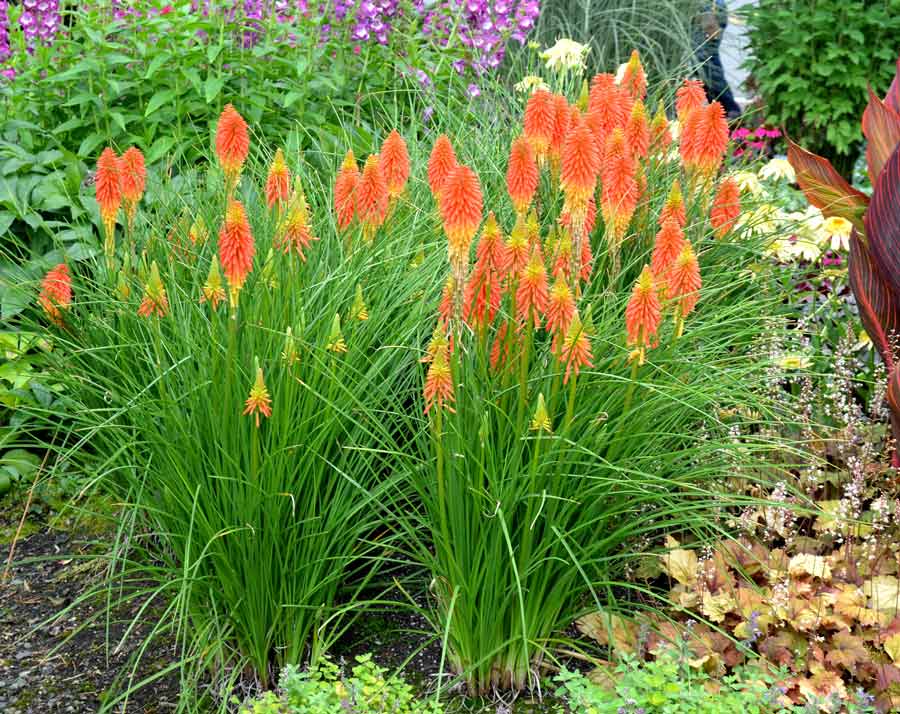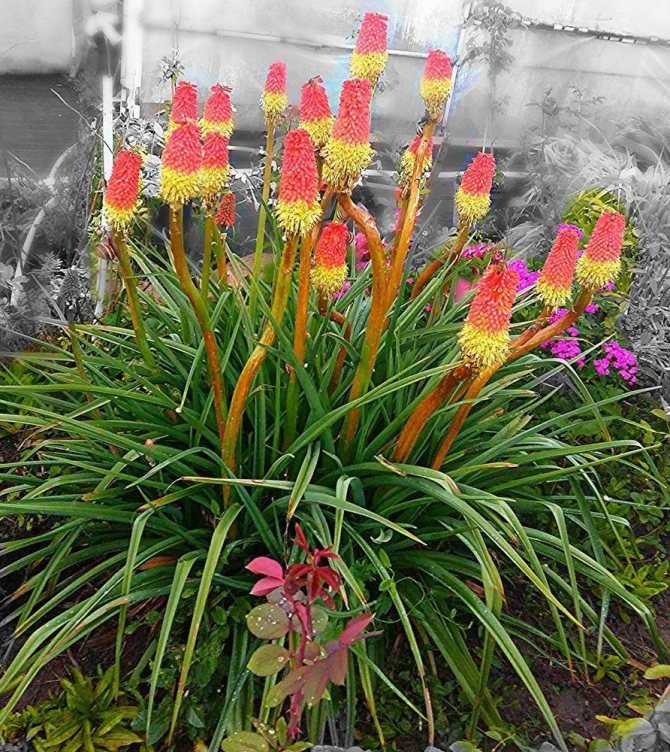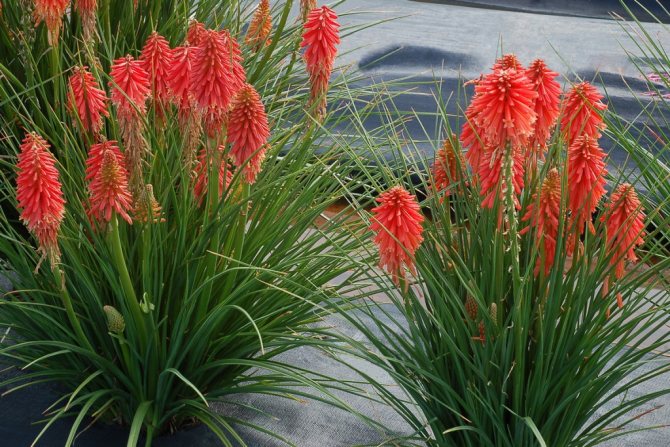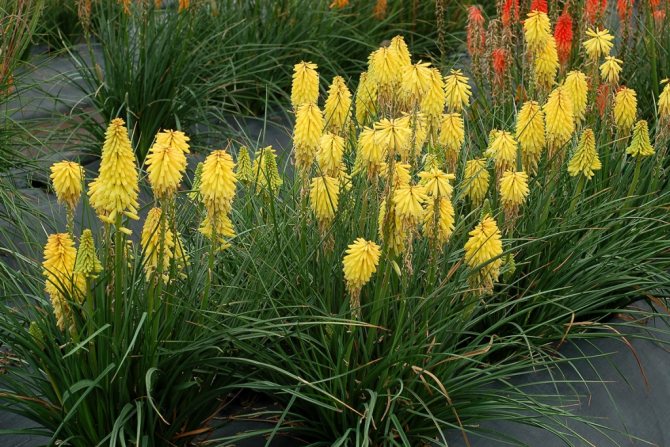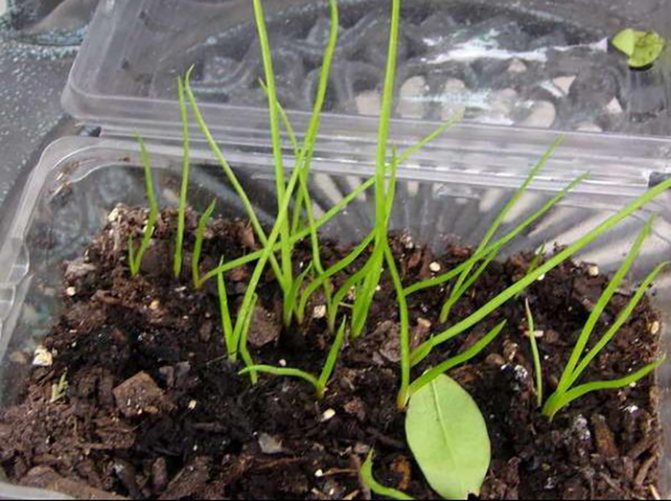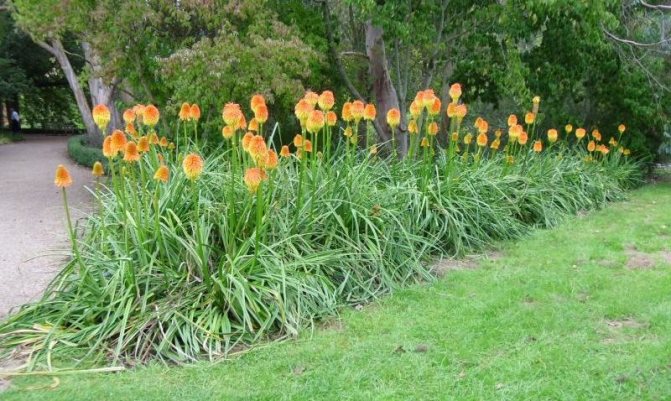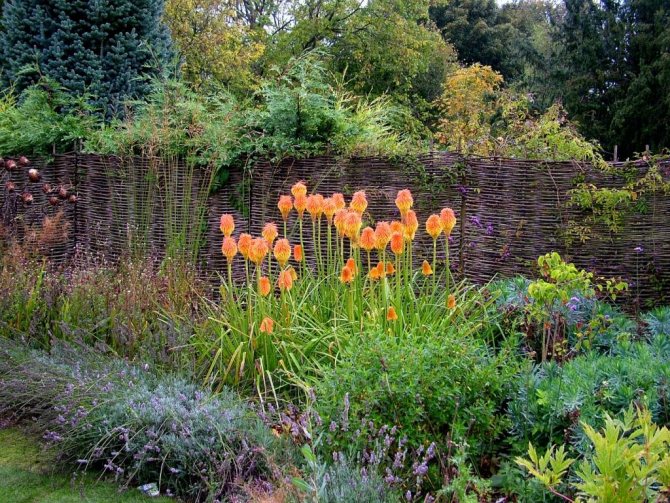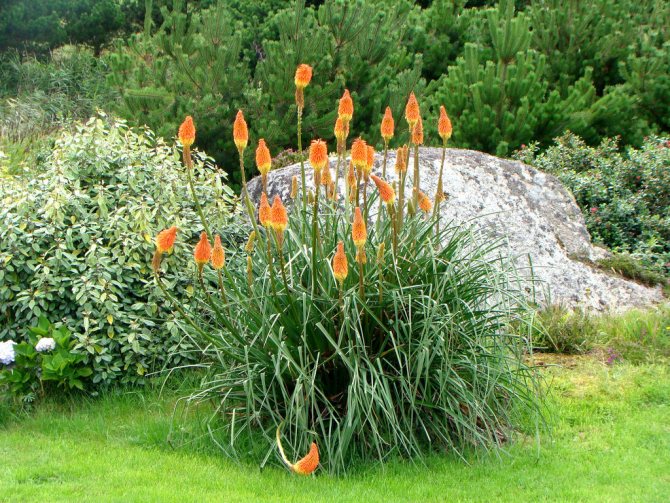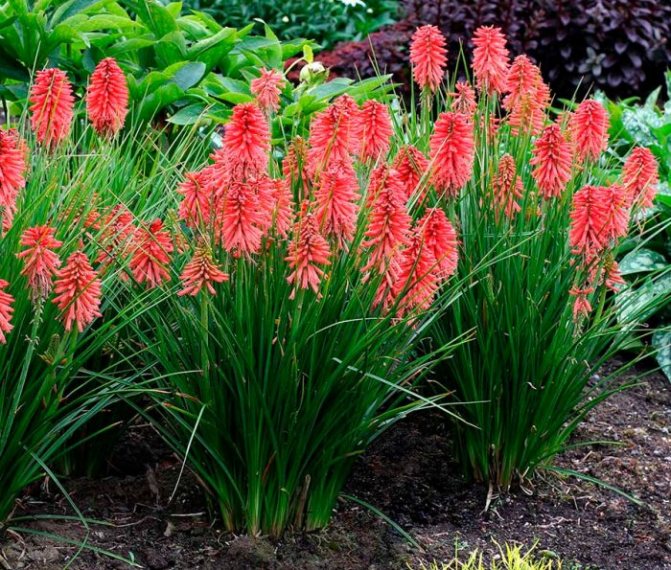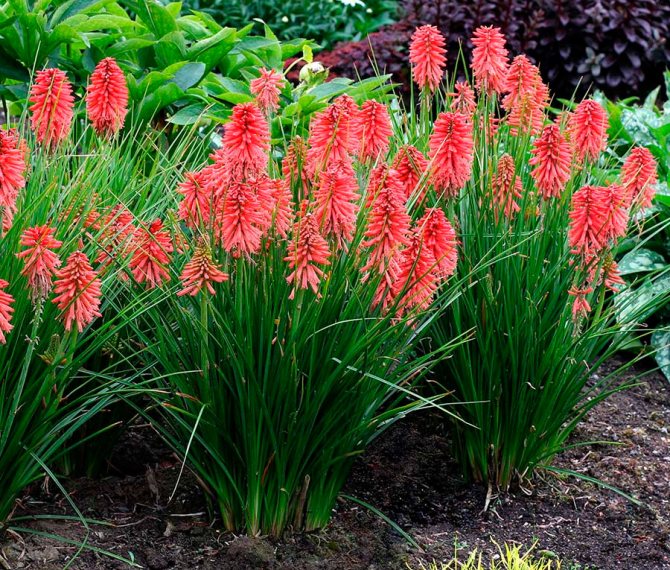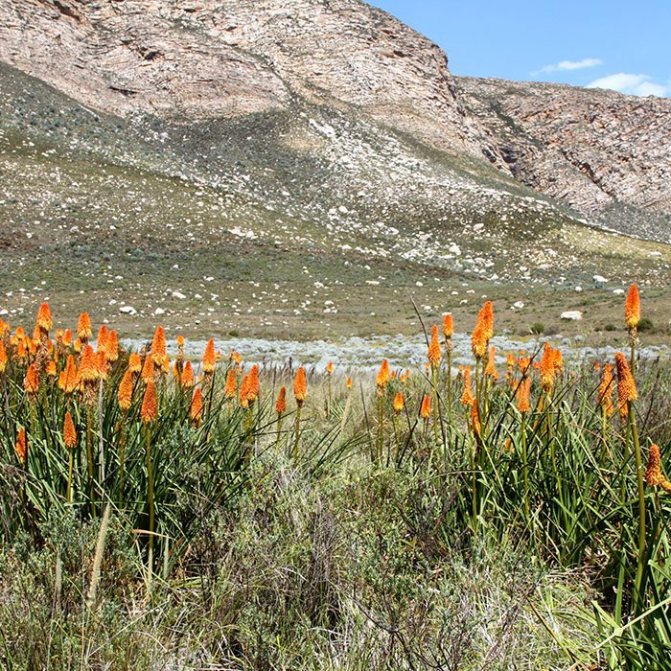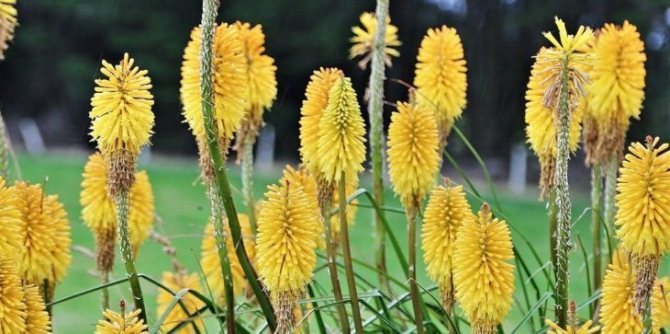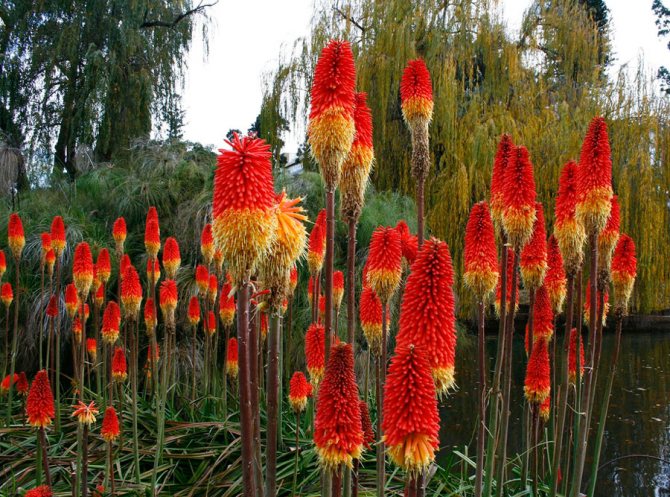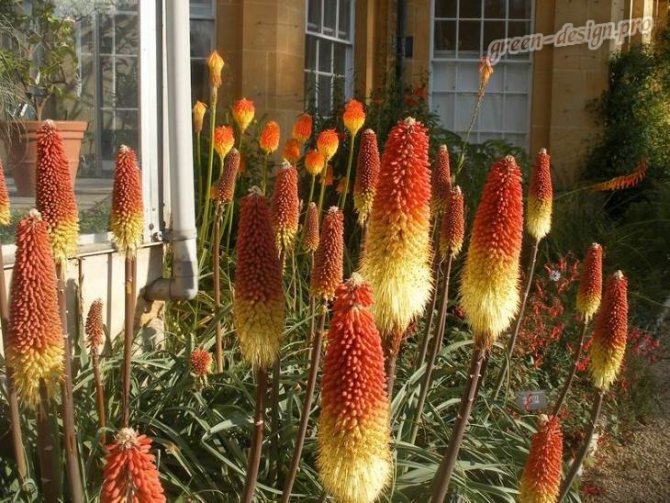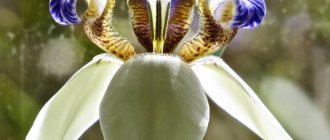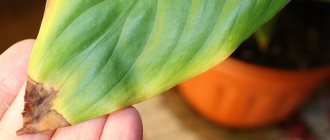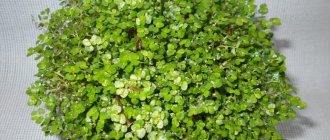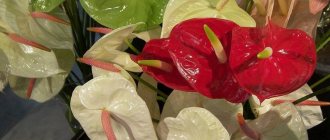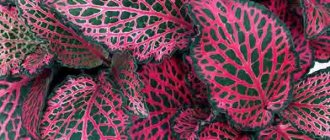The herbaceous perennial plant Kniphofia, also called kniphofia, is a representative of the Asphodelic subfamily of the Xantorrhea family. In nature, such a plant grows in Eastern and South Africa, while it can be found at an altitude of up to 4 thousand meters above sea level. Previously, this genus was a representative of the Liliaceae family. It unites 75 species, some of which, as well as hybrids of knifofia, are cultivated as flowering plants. This genus was named after the German botanist Johann Jerome Kniphof.
Knifofia: varieties and varieties
Some species of this African plant, as well as hybrids of perennial bniphophy, are distributed throughout the globe as ornamental garden plants.
Types of kniphofia are divided into groups:
Berry. This is the tallest group. Some popular varieties:
- Dr. Kerr Lemon;
- OrangeBeauty Orange;
- Macowen.
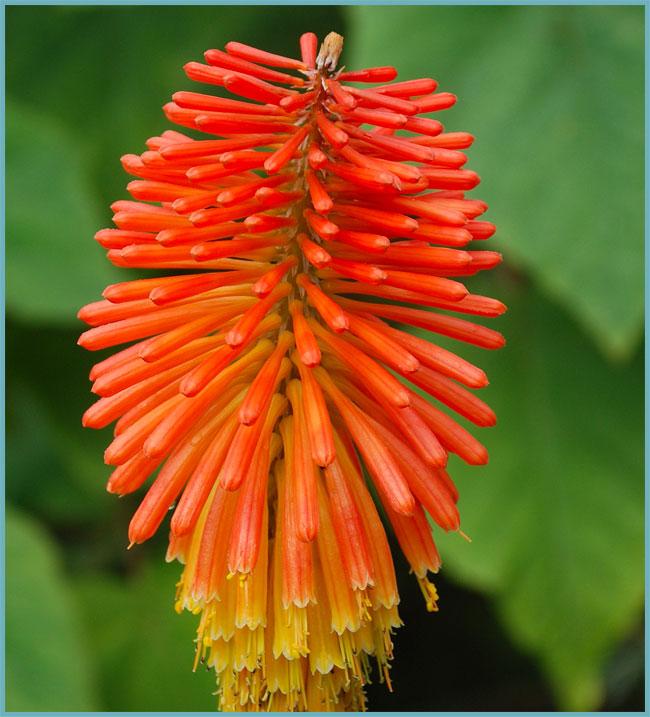
Berry knifofia
Tukka. This is the most stable species for our climate.
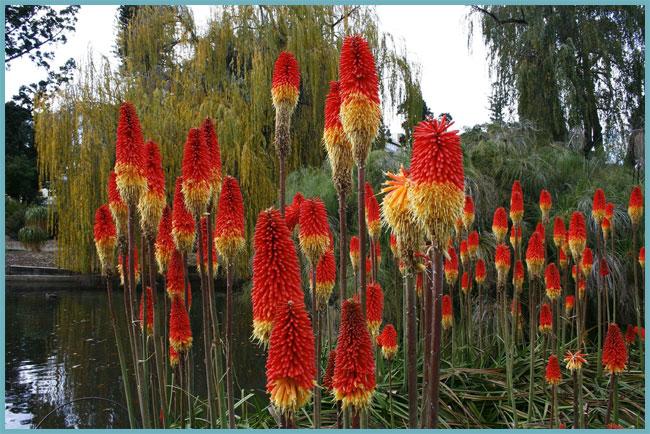

Knifofia tukka
Hybrid. Hybrid varieties are mostly bred on the basis of berry knifophy. The most popular varieties:
- Cobra;
- Cardinal;
- Rocket;
- Atlanta.
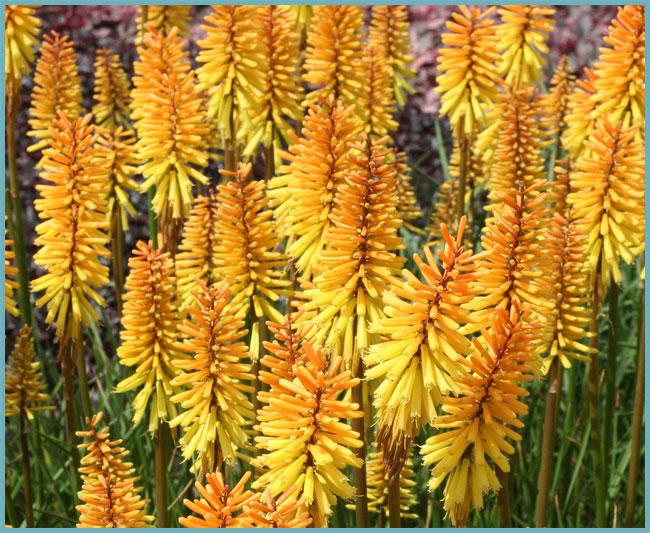

Hybrid knifofia
Attention! Existing plant names: knifofia, kniphofia, tritoma, notoskeptrum.
Features of knifophy
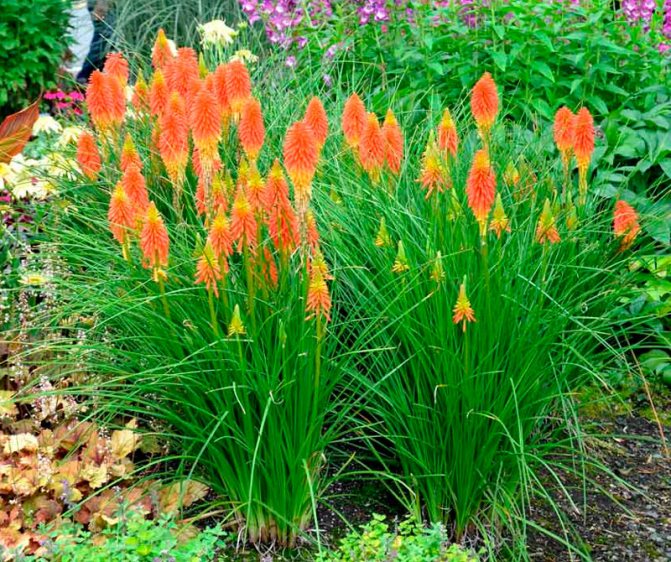

The flowering plant knifofia is an exotic perennial that can be evergreen. The height of the bushes varies from 0.6 to 1.5 m. At the same time, the Thomson cniphophy species can have a height of about 300 cm. The short rhizome is quite thick. The root rosette consists of xiphoid leathery leaf plates. Leafless peduncles grow from the middle of this rosette, which bear apical inflorescences of a sultan-shaped or spike-shaped form. The inflorescences include drooping small flowers of red, yellow or coral color. Such a culture has one distinctive feature, namely: the buds (most often red) and flowers (most often yellow) on the same bush are painted in different colors. Knifofia blooms in the middle of the summer period, and the faded bush does not lose its spectacular appearance until late autumn. The fruit is a capsule.
Plant care
Cultivation of knifophy does not require any special hassle. The difficulty lies only in preparing the plant for winter. The main care includes weeding from weeds, mulching and timely watering, fertilizing with fertilizers twice a season.
Every 5 years, the plant requires division and reproduction of the bush with rosettes. At the end of flowering, the peduncles are cut off, and the leaves are tied in a bunch for the winter and covered with sawdust or leaf litter, coniferous spruce branches. Cover from above with any waterproof material.
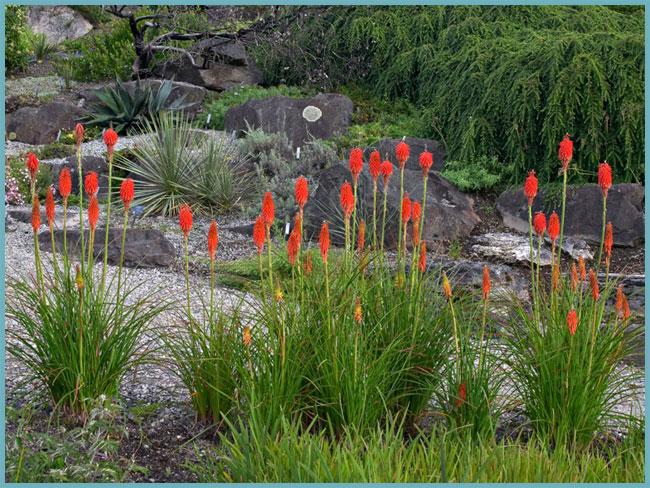

The main task of the gardener is to protect the knifofia from freezing in winter.
But if there is little snow in winter or a wet winter, then the knifofia can die from freezing or from damping off. It is better to play it safe and transplant the plant into a container for the winter period. Tie the leaves and place the container in a dry room with a constant temperature of 1-8 degrees. It will periodically need to moisten the soil. The plant is planted in open ground at the end of May.If there are sheltered plants in your garden, then you should gradually open them so that they get used to the sunlight. After the appearance of the first leaves, fertilizing is performed.
Gallery: knifofia (25 photos)
Fertilization and feeding of knifofia
In the spring, when the first green leaves appear on the plant, it is necessary to feed the cniphophy with nitrogen fertilizers. This can be an infusion of chicken manure, diluted in the right proportion, or mineral fertilizer bought in a store. The plant responds well to the application of organic fertilizers:
- compost;
- humus;
- peat.
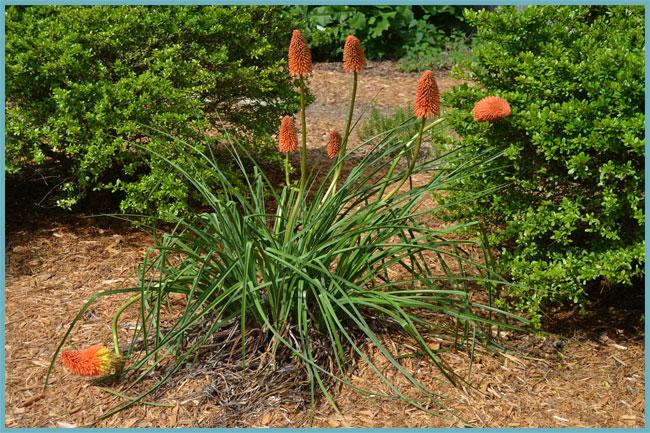

For the rapid development of the plant, spring feeding is required.
In the second half of the growing season, potash fertilizers or ash can be applied. This will help the plant to better endure the period of winter dormancy.
Varieties
Before planting knifofia, you need to understand the features of common varieties.
Dr. Kerr
This is a unique variety, in which flower stalks grow up to a meter in length. In this case, the height of the inflorescences is 25-30 cm. Dr. Kerr can be distinguished from other varieties by the bright colors of the petals, which have a lemon hue. The advantages of the variety include:
- long flowering;
- resistance to low temperatures;
- powerful stem.
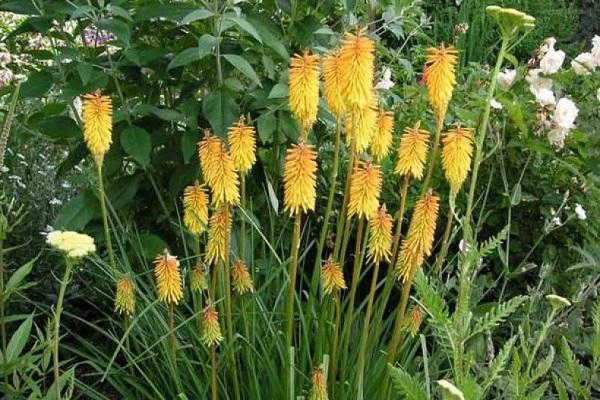

Orange Beauty
A tall, two-meter variety, which is often planted in large flower beds. Orange Beauty leaves are huge, they grow up to fifty centimeters in length. The flower blooms in July and stops flowering after 60-70 days.
Fire Flame
For garden decoration, Fire Flame is perfect, which has a unique fiery red color of the petals. The variety can be grown both in the open field and in greenhouses. The seedling, like many other varieties, begins to bloom in July.
Popsicle
A tall seedling that is often grown in flower gardens. A distinctive feature of the Eskimo is that its flowers are arranged in two tiers. Below are bright yellow buds, and on top are coral inflorescences.
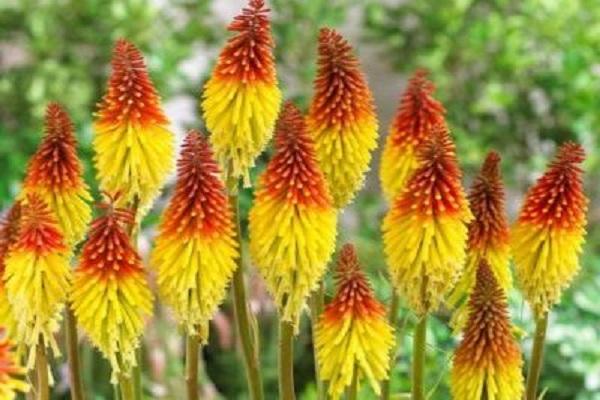

Abendzonne
This is a plant with large peduncles, which, when properly grown, grow up to 25-30 centimeters. The seedling is very tall and therefore needs to be tied to supports. Abenzonne blooms in late June.
Cardinal
Another tall plant, in which the peduncle grows up to one and a half meters. To prevent the planted seedling from breaking due to strong winds, it is tied to support columns. Cardinal's buds are colored bright red.
Burnox Triumph
A short sapling that can be grown in pots or boxes. The maximum height of this variety is only 45-55 centimeters. Bernox Triumph will bloom in June, flowering lasts a month and a half. The buds are colored orange with a golden tint.
Golden Skeeper
This is a tall seedling that is only suitable for outdoor cultivation. The main stem grows up to 120-140 centimeters. In summer, large inflorescences appear on it, which become bright yellow during the flowering process.
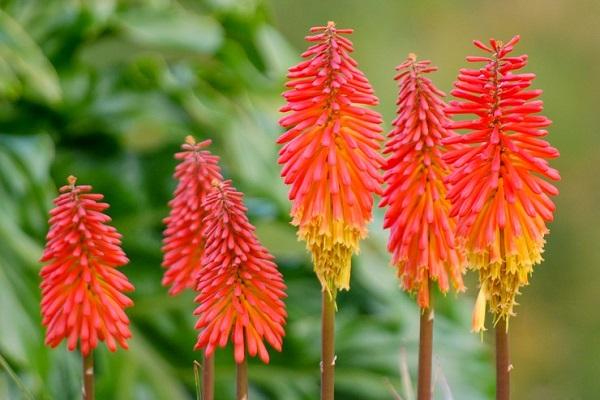

Indiana
A medium-sized flower with a powerful stem that grows up to 80-90 cm. Among the advantages of Indiana, they distinguish resistance to temperature extremes, diseases and pest attacks. During flowering, large orange flowers can be seen on the bushes.
Royal Standard
This is a fairly old variety that is still popular among flower lovers today. Royal Standard is distinguished by medium-sized bushes, the stem of which grows up to 75-80 cm. The seedlings have lower flowers that are colored yellow, and the upper ones are bright red.
See also
Planting and caring for a poultry farm in the open field, description of speciesRead
Prince maurito
It is an unusual flowering bush with large green leaves and a thick main stem.The main difference between Prince Maurito is the color of the inflorescences, which are colored brown. This variety blooms in the first half of July.
Theo
A medium-sized seedling that begins to bloom profusely after June 20-25. Theo bloom lasts 1-2 months and ends before the autumn cold snap. The flowers of the variety are colored reddish with a faint orange tint.
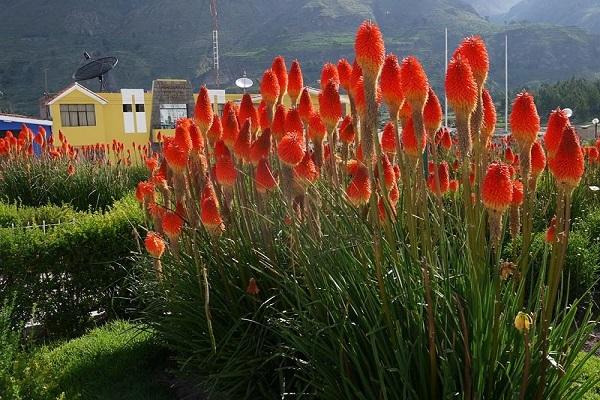

Rocket
This is an exotic variety that is rarely found in the flower beds of summer residents. Rocket grows up to fifty centimeters, but sometimes the height of the seedlings reaches a meter. The flowers of the seedling are small, have a reddish color. They bloom in 1-2 months after planting in open ground.
Knifofia hybrid Fleming Torch
This floral hybrid differs from most other cniphophy varieties in its compactness. Small seedlings can grow up to 55-65 centimeters. Thanks to this, some growers grow Fleming Torch in pots.
Flamenco
Tall flower, painted in red-yellow colors. Outwardly, Flamenco resembles brightly flaming torches. The flowering of the variety begins in mid-July and lasts until the last days of September.
Macowen
A medium-sized flower plant that grows up to 75 centimeters during the flowering period. At the same time, Macowan's inflorescences grow up to 10-15 cm. Blooming buds are colored orange with a slight golden tint. Among the advantages of the variety, the resistance to high humidity is distinguished.
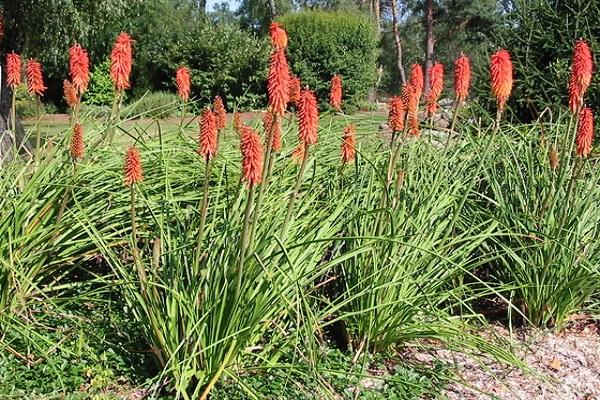

Surprise
This is a beautiful plant with flowers in the upper and lower parts of the bush. The flowers below are dark pink in color. The upper buds are brighter, as they are colored golden.
Alcazar
An exotic perennial flower, the bushes of which are up to a hundred centimeters high. This plant is not frost-resistant and is therefore often grown in greenhouses. Blooms in July and blooms until early September.
African guest
This tall variety attracts attention with the variety of its inflorescences. They differ from each other in their color. Some of them are painted pink or red. Burgundy buds with an orange tint are also common.
Bengal fire
One and a half meter flower bush with small inflorescences of yellow, coral or burgundy color. Bengal fire buds are spike-shaped, their length is 15-20 cm.
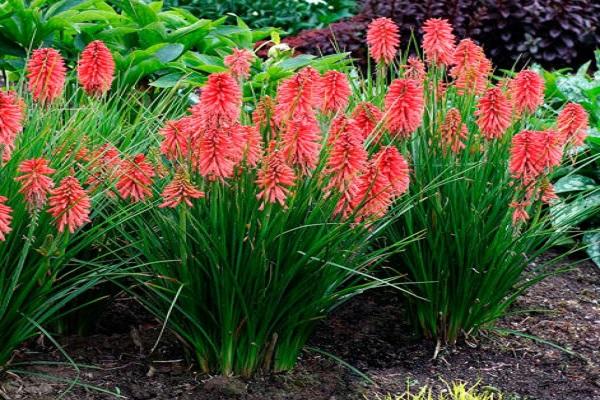

Fleming jerk
Tall knifophya, adult seedlings of which can grow up to two meters in height. Fleming's inflorescences are also long - 20-30 centimeters. The buds are yellowish with a reddish or orange tint.
Eming fan
Another knifophy, which refers to tall plants. Its bushes reach one meter. At the beginning of summer, small flowers appear on the seedlings, which are colored red. After flowering, the buds brighten and turn yellow.
Tukka
People living in regions with unfavorable climates can plant the Tukka variety. Such a flower is resistant to drops in temperature and high humidity. Active flowering begins in the first days of summer.
Martian
A perennial flower with a powerful root system. The Martian grows up to one and a half meters, the flowers are pinkish and have a red tint. This variety is thermophilic, and therefore it should be grown only in illuminated areas in the garden.
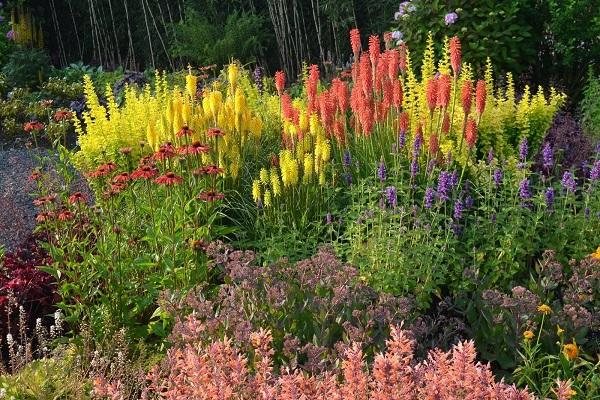

Cobra
This variety is suitable for people looking for late blooming flowers. Cobra buds bloom in early August. Flowering continues until the first night frost.
Atlanta
Medium-sized knifophy, which is often used to create flower arrangements in a flower bed. Atlanta has large orange-colored buds. They bloom in the summer and bloom until the end of August.
Reproduction of the plant of knifophy
Perennial bnifophyia in the open field can be propagated by seed or by dividing the bush.
Seeds Knifofia is rarely grown, since in the middle lane the seeds of the plant do not have time to fully ripen.Therefore, it is possible to plant perennial knifofia only by using purchased seed material. Seeds are sown in seedling pots in early spring to speed up seedling, cover with glass. After three weeks, the first shoots will appear, the film is removed, and when the plant has three leaves, it dives. In early summer, the plant can be planted in the garden in a permanent place. After 2-3 years, the first inflorescences will appear.
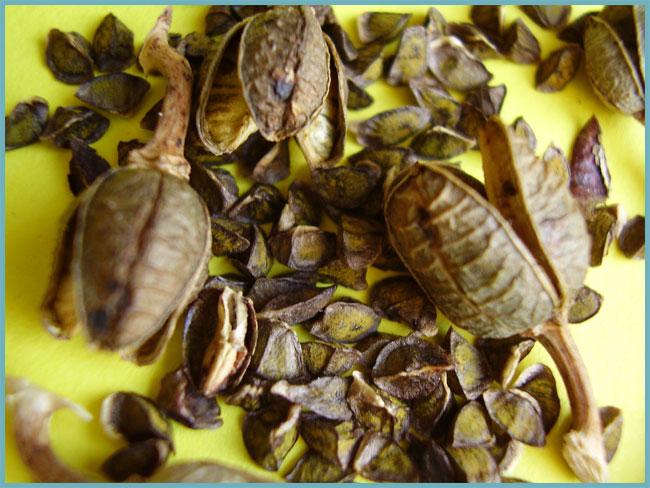

Seeds of knifophy
Dividing the bush allows you to achieve flowering cnifophya within a year after planting. In early May, the bushes are dug up and daughter rosettes are separated from them. They are planted in prepared holes at a distance of 30-40 cm and watered well. After planting, young bushes should be shaded for the first time, so they will take root better.
Advice. Knifofia loves moderate watering, excess moisture can lead to the death of the plant.
Growing conditions
It is more difficult for African species to take root in our conditions, so you need to make them as comfortable as possible. Soil and site selection are important. Knifofia is a thermophilic plant and is not afraid of sunlight. If the conditions are not met, the culture may start to hurt due to a decrease in immunity.
Seat selection
Semi-flooded lowlands are especially dangerous for the knifophia. In this case, the horse system does not receive oxygen and rots. Open areas and slides are good places to grow. In spring, they warm up faster and stimulate root growth. Rooted plants do not need shelter from the sun's rays, but it is better to shade young seedlings until they get stronger, so many housewives transplant the bushes to a new place after the first year.
The soil
Well-drained soil with an admixture of sand is necessary for knifofia. It is important that constant humidity is maintained. If the roots dry up, the supply of nutrients dissolved in water stops and the tissues lose turgor - intercellular pressure.
Loamy soils are suitable, but additional fertilization and watering will be required to dissolve the granules. Clay is not the best solution for growing knifofia, since the substance does not allow moisture to pass through well. Areas of clay soil must be dug up and mixed with turf, sand or peat, and humus must be added to improve nutritional characteristics.
Interesting! In cooler climates, it is recommended to lay out dark stones in the flower bed at night. During the day they accumulate heat, and at night they give it to the roots.
Diseases and pests
With good care, timely watering and top dressing with potash fertilizers, the knifofia will not be capricious and sick in the open field. With excessive watering, the plant can get sick with root rot, if this does happen, then immediately take measures for treatment - pour it with fungicide. If time has already been lost and the plant is not subject to recovery, then remove the affected plant from the flower garden as soon as possible so that other flowers in your garden do not get sick.
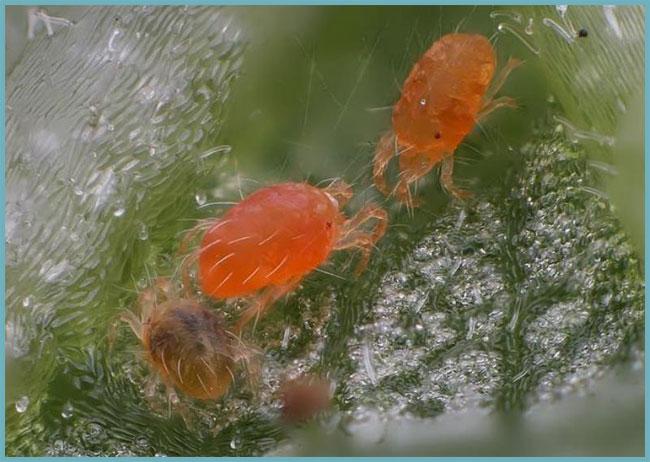

Spider mite
Insects are also not averse to feasting on an African beauty. These are mainly leaf-eating and sucking insects: aphids, spider mites, thrips. Spraying with an insecticide will help here.
Attention! All sucking insect pests love plants overfed with nitrogen and other fertilizers.
Important points in growing
- Knifofia should be planted every five years by dividing the bush;
- The plant should be planted only in high terrain, there should be a bright light;
- The area should be calm, since the plant does not like drafts;
- In spring and autumn, do not forget to feed the plants with potash fertilizers;
- If the plant freezes, place stones at the very bottom of the plant for sufficient warmth. The sun will heat them up and the plant will be warm from this;
- The plant will not withstand temperatures below -15 degrees.Therefore, if the winters are cold, then bring the plant home.
Let these tips help you in the future. Having learned something new or gleaned practical advice and recommendations, the plant will delight you again and again! Successful plant growing!
Knifofia: combination with other plants
When composing a composition for a mixed planting of knifophya with other plants, one should take into account the flowering time, as well as the care and watering requirements for the plants to be comfortable.
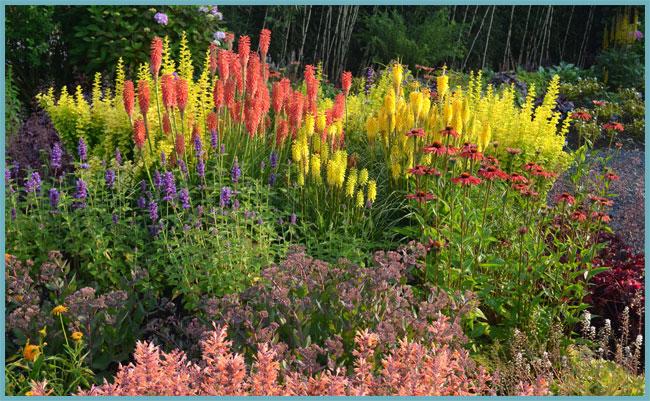

Knifofia in the flowerbed
In landscape design, knifofia is often combined with other perennials:
- sage;
- bearded iris;
- gypsophila;
- decorative cereals;
- eremurus;
- lupine;
- dahlias.
Types and varieties
In total, there are about 70 species of this plant, most of which are found exclusively in the wild and grows in the hot and dry climate of Africa. Among those cultivated in the middle lane, the following varieties can be noted:
- berry knifophya (Kniphofia uvaria). This species is one of the tallest, growing more than two meters. This variety began to be cultivated back in the 18th century. The most popular varieties are: berry knifofia Eskimo, berry knifofia Martian, Dr. Kerr... At the same time, depending on the difference in varieties lies in the varied color of flowers;
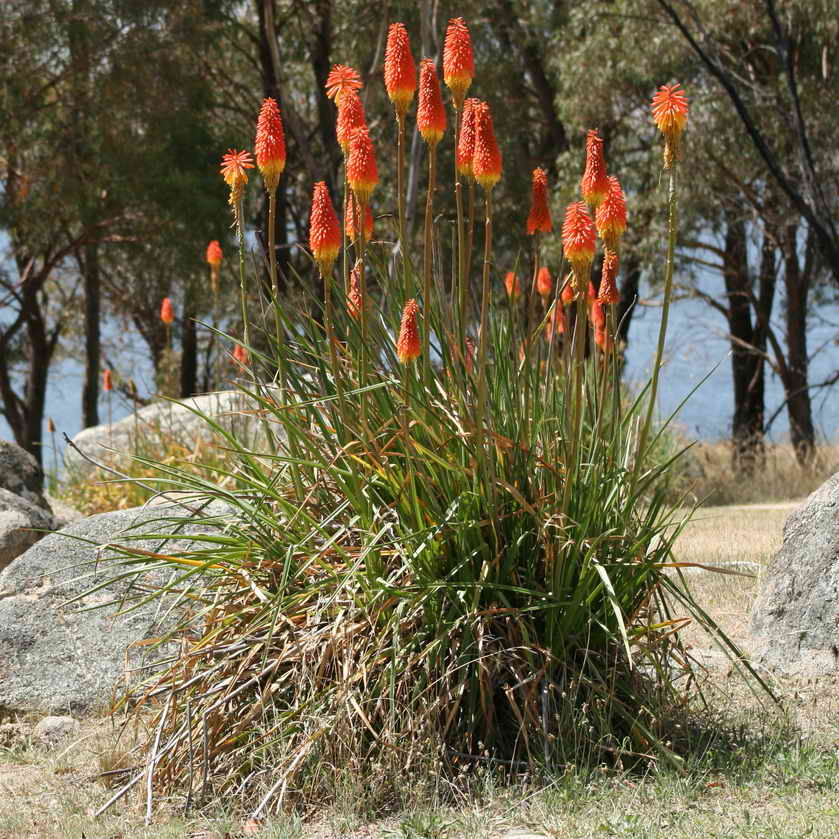

- knifofiya Tukka (K. tuckii)... Another variety that is most often found on window sills. This species is one of the most cold-resistant, and resistant to changes in climatic conditions. It is also distinguished by low height, rarely exceeding 80 cm;
You can see her in the title photo.
- hybrid knifophy (K. hybrida). This variety includes artificially created varieties based on berry knifophy. The most common are Fleming Torch, Alcazar, Seliano.
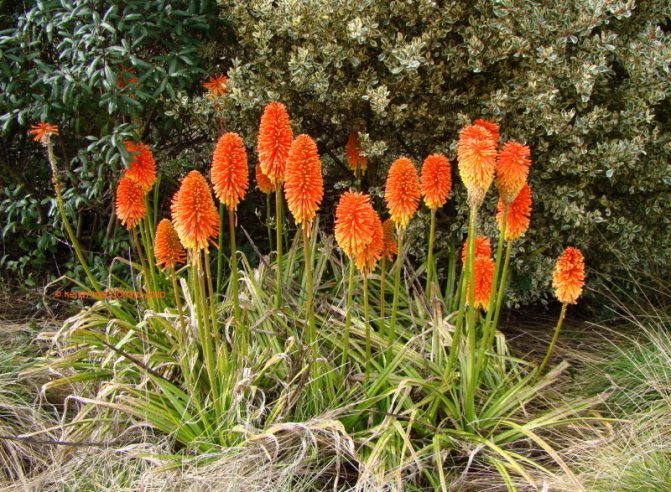

Knifofia in landscape design
Perennial knifofia does not lose its decorative effect throughout the growing season, therefore it is often used in landscape design. She looks great as a solo soloist on the lawn, as well as in combination with other plants in flower beds, she feels good near ponds and in dry gardens.
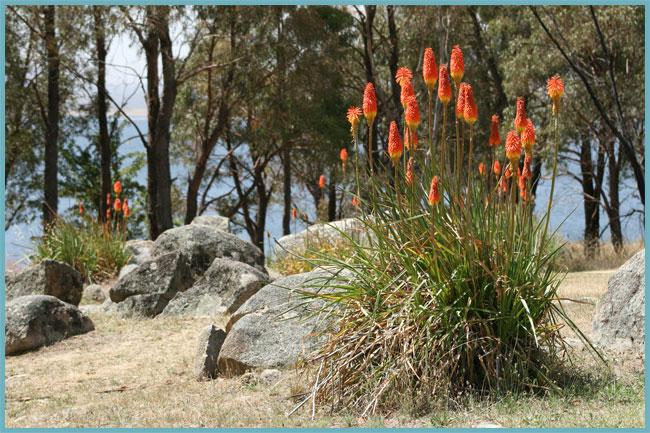

Knifofia feels good in different conditions
Tall varieties can be used as a screen, but low-growing varieties in landscape design can decorate a rockery or an alpine slide. Knifofia looks great not only in the garden, cut inflorescences will stand in a vase for at least two weeks as a home decoration.
Description of the plant
Knifofia is a very unusual flower. With proper care, the plant can grow to a height of three meters. It has a spike-shaped inflorescence of tubular flowers. Flowers during the flowering period can change their color from yellow to orange and bright red. Knifofia blooms from mid-summer until the first frost appears.
Cnifophya has a well-developed thick root system. The leaves are very dense, narrow and long, resembling reed leaves, collected in a basal rosette. The leaf plates are colored gray-green.
The flowers are small, tubular, individually similar to bells, collected in large lush inflorescences of a spike-shaped form, which is located on a long, leafless peduncle. With the onset of the flowering period, the buds open from the lower or upper part of the ear, depending on the plant variety.
A distinctive feature of knifophya is the ability to change the color of flowers: at the beginning of flowering, they are bright red, during the blooming of the bud, it turns orange, then the flower becomes bright yellow or lemon.
Types of bnifophy: photo
Wintering
The organization of wintering directly depends on the variety of the planted culture and the climatic conditions of the region. In regions of the III climatic zone, the Tukka variety winter safely.Having opted for more thermophilic varieties and hybrids, you should be prepared for the fact that they may not survive the harsh winter. In northern latitudes, the plant must be dug up for the winter, regardless of the species. The milder climate of the III region allows growing the berry group of the plant, however, the garden will need a winter shelter, and in many areas the plant will have to be dug up for the winter for storage.
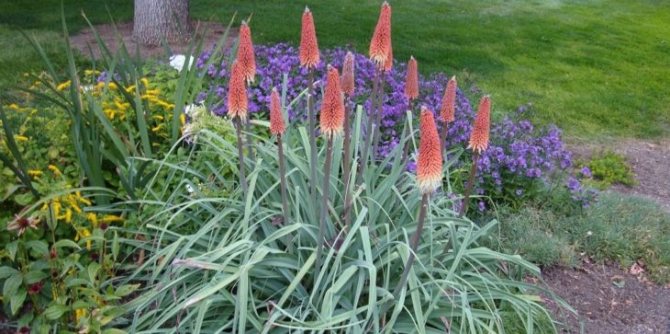

If the winter in a given area is mild, the knifofia can survive the cold under safe cover. An important condition is the "sealing" of the rosette wintering in the ground. To do this, the leaves must be tied in such a way that water does not penetrate into the center of the outlet. The use of additional materials is acceptable. From above, the bed is sprinkled with foliage, covered with spruce branches or covering material.
The borderline threshold of winter temperatures for knifophia hibernating under shelter is -15C. If there is a risk of more serious temperature drops, the plant will have to be dug up, placed in a container with an equipped drainage layer, covered with nutrient mixture and brought into a cool room. The optimum temperature for winter maintenance is +8 C. The return transfer to the ground is carried out after the snow melts and a stable heat is established.
Possible problems
Certain dangerous diseases and pests can kill knifophy.
- Of the pests, leaf-eating insects (aphids, spider mites) are widespread. They appear on seedlings. To get rid of them, it is necessary to spray with insecticidal agents.
- Rot is common among diseases. It develops on the roots. The reason for its appearance is waterlogging of the soil. First, the roots are treated with a fungicide. If this did not work, then the diseased bushes are eliminated in order to prevent further spread of the disease.
Planting and caring for a knifofia is a complex procedure. This is due to the fact that the plant originated from Africa. It requires a lot of sun and warmth. The most dangerous for him is excessive moisture, which can provoke the appearance of the disease. In any case, those who dare to grow this miracle will delight the plant with its unusual flowering.
Choosing a landing site
The light-loving knifofia will not bloom in the shade, and the roots are also afraid of dampness. For example, plant your bushes in areas with bright sunlight. Avoid lowlands and flooded areas, it is better to choose a site on a hill, with a close occurrence of groundwater, build a high bed.
The soil needs moisture, water and air permeable. Sandy soils pre-filled with humus are ideal (add it for digging 30 days before planting, spending 3-4 kg for each square meter of the site).
Description and characteristics of knifophy
Knifofia is one of the most beautiful exotic plants. Its vegetative terrestrial parts are capable of retaining their natural green color throughout the year. The height of the shoots reaches about 60-150 cm. Some varieties grow about three meters in length. The root system is poorly developed. The main root is thick and short. The leaf blades look leathery, grow out of the root rosette. From straight peduncles spike-shaped inflorescences bloom, collected from small reddish and yellowish flowers. A distinctive feature of the plant is the fact that flowers and buds have different colors. Flowering falls in July. At the end of flowering, the cniphophia still looks attractive and does not lose its decorative grace until the onset of frost. In place of the inflorescences, seed bolls ripen in the future.
Problems with growing knifofia
When growing an exotic flower, the gardener may face some challenges. To avoid this, you need to study all the nuances of caring for this crop.
When breeding knifofia, it sometimes happens that the plant does not bloom.Flowering may be absent if an inappropriate place is chosen for planting in the shade, partial shade, in an area with a close occurrence of groundwater. In the absence of flowering, you need to transplant the culture. If this is not done, she may die.
In regions with a warm climate in winter, you need to open the film so that the plant can get air. Otherwise, there will be overheating of the knifofia, decay of the central outlets and the root system.
It is worth remembering that it is recommended to apply fertilizers not immediately after planting or transplanting the plant, but 2 weeks after that.
Sometimes the gardener has to deal with pests and diseases of the exotic. So, with stagnant moisture in the soil, root rot develops, which most often leads to the death of the flower. To prevent the disease from infecting neighboring plants, knifofia should be dug up and burned.
To prevent root rot, a drainage layer is made in the planting pits. If the plant is slightly damaged, the affected parts are cut off, the cuts are sprinkled with charcoal, and then sprayed with Bordeaux liquid.
Crop pests include aphids that suck the juice from the leaves and stems of the flower. To prevent the appearance of aphids, herbs with a strong odor or green manure plants are planted next to the knifofia. With an aphid invasion, the flower is sprayed with insecticides.
Thrips, small insects of 1 - 2 mm in size, can also damage the bush. They suck sap from various parts of the flower and are carriers of many diseases. If pests are found, the plant is treated with Fitoverm insecticide.
Sometimes a white cobweb can be seen on the bush. This indicates the presence of a spider mite - a pest that sucks out the juice and eats the leaves of the plant. In the fight against spider mites, insectoacaricides are effective, for example, "Actellik", "Appolo", "Demitan", "Karate", "Neoron", "Nissoran" and others.
Long-term practice of experienced gardeners shows that proper care after planting a bniphophia flower will help to avoid diseases and pests.
Blossoming knifofia
The bloom of bnifophya is special! Blooming of buds occurs gradually, and can start from the lower tiers or from the upper ones, depending on the species and variety. Another amazing feature of its inflorescences is their ability to change the color palette.
Each species / variety has an initial color (for example, red), which subsequently changes to another (for example, orange), and in some specimens more than once.
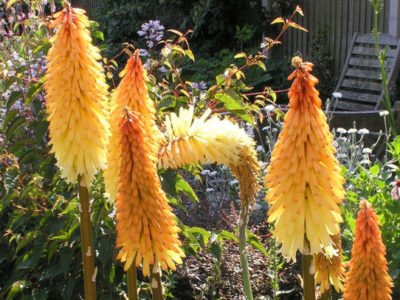

How to water and feed knifofia
It is recommended to water the flower after the top layer of the earth has dried. Usually watering is done every 3-4 days. If there is a drought for a long time, then you can water the plant more often than usual. Water the plant early in the morning or late in the evening so as not to provoke leaf burns. So that watering, loosening and weeding is required less often, you can cover the soil surface near the plant with a layer of mulch, which can be taken as sawdust or peat.
In early spring, the plants can be fed. This is done before the buds begin to form. For spring feeding, it is advisable to take organic matter or nitrogen-containing fertilizers. From organic fertilizers, humus is well suited, it is better not to use manure, it poses a danger to the plant. You can also use homemade compost and wood ash.
The second time the knifofia is fed when it fades. For the second feeding, it is recommended to use potash mineral fertilizers.
Throughout the growing season, knifofia needs phosphorus. To provide the plant with this important element, phosphate rock can be used. It is added to the soil in the spring before transplanting the plant into the ground. This fertilizer has a long working life, it should be applied no more than once every 3-4 years.
Primer for knifophy
The requirements for the soil are fertility, good moisture and air permeability. Water stagnation is absolutely contraindicated, since dampness in most cases leads to decay of the root system.
Moreover, sandy, well-loosened soil is only welcome, and you can prevent excessive evaporation of moisture by mulching the ground within the radius of the stem with small pebbles or pebbles.
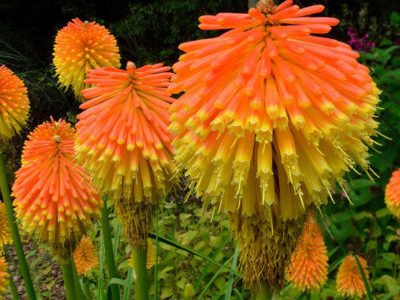

Knifofia: care, principles of growing
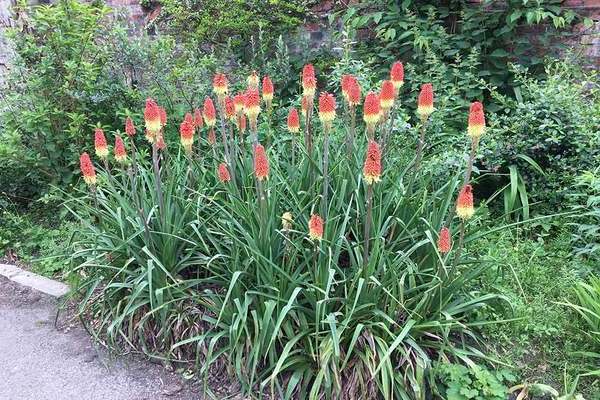

Knifofia: leaving
Everyone can grow knifofia in the simplest way - by planting seeds, through seedlings Seeds begin to be planted at the very end of March or at the beginning of April. For planting knifofia, shallow boxes are taken. They must be pre-disinfected, and then filled with a soil mixture for flowers. The seeds are carefully scattered over the surface of the soil, and then lightly sprinkled with earth from above. Then it is advisable to cover the boxes on top with a film, which must be lifted regularly to provide oxygen access. Before emergence, the boxes can be placed on the windowsill. They need to be watered systematically. The first shoots will appear no earlier than 15-20 days. Until that time, one must not forget about airing and watering so that the soil does not dry out.
After the emergence of seedlings, they should be under the film for some time. They should be taught to room conditions gradually. To do this, it is necessary to lift the film every day, constantly increasing the time for which the plants remain uncovered.
When the first pair of true leaves appears in the knifofia, it must be planted in individual containers. Small cups are suitable for this. It is worth remembering that this plant does not tolerate sudden changes in temperature, the knifofia reacts very badly to a cold snap. Therefore, the room temperature must be stable. Seedlings need to be regularly sprayed with a spray bottle. There is no need to feed the seedlings, because the mixture for planting it is initially saturated with all the substances necessary for the flower.
Amazing plant
Periwinkle planting and care in the open field photo
Almost in many gardens, plants of the same type are of the same type, and when there is an exotic piece from another continent among them, everything changes and no longer seems so familiar or "like everyone else."
Indeed, for each gardener, the garden and the vegetable garden are his brainchild, therefore, each one distinguishes them in his own way. You can look at the bnifofii photos and immediately understand that this plant will bring new, fresh notes to your garden.
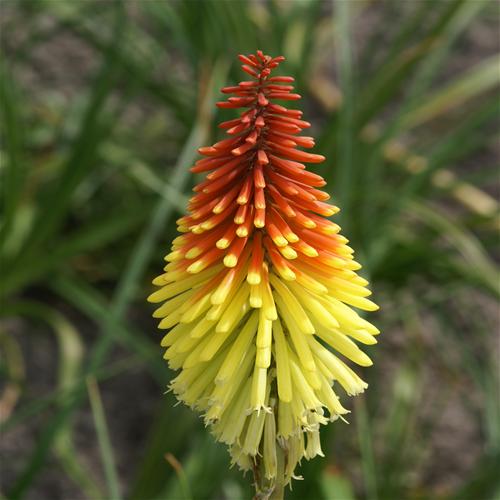

This plant will bring new, fresh notes to your garden.
The homeland of this exotic plant is Africa. It perfectly performs a decorative function, and for many this is an important factor. There are about 75 types of flowers, which are divided into groups:
- Hybrid.
- Macowen.
- Taka.
- Berry.
Description of cniphophy: it has both narrow and wide leaves, their length reaches 90 cm, large peduncles, at the end of which there are flowers in the form of tubes.
The peculiarity of this flower is that, starting from the base to the very tip, its colors pass from light to dark, changing different shades. Having cut such flowers for your home, you can be sure that they will stay with you for a long time, since when cut, such a flower retains its appearance for up to two weeks.
Knifofia blooms almost the entire season, namely, from June to September. You can experiment with such flowers, you can plant different in height and color, combining with each other or with other colors.
Fertilizer for knifofia
Regular feeding will help to increase the volume of flowering and stimulate growth.
In early spring, you should feed it with complex fertilizers, and before planting you need to add organic matter (in the future, its introduction will also not be superfluous - every year in spring). As soon as flowering ends, potash fertilizers or ash are applied.
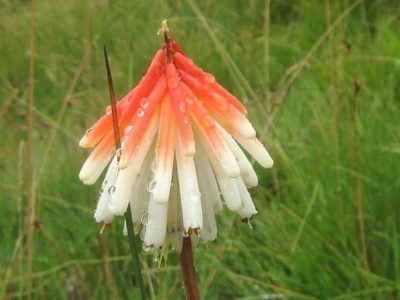

Features of growing an ornamental culture
The origin of the plant dictates its own laws - for a favorable vegetation and confident flowering, most varieties require a hot climate with sunny weather and short mild winters. In the northern regions and the central part of Russia, only one species of perennial is more often planted - the knifofia Tukka.
It is better to grow an exotic flower in areas where the sun reigns most of the day - elevated areas, southern slopes. In order for the plant to bloom longer, only a slight partial shade is allowed. When determining the landing site, drafts should be excluded.
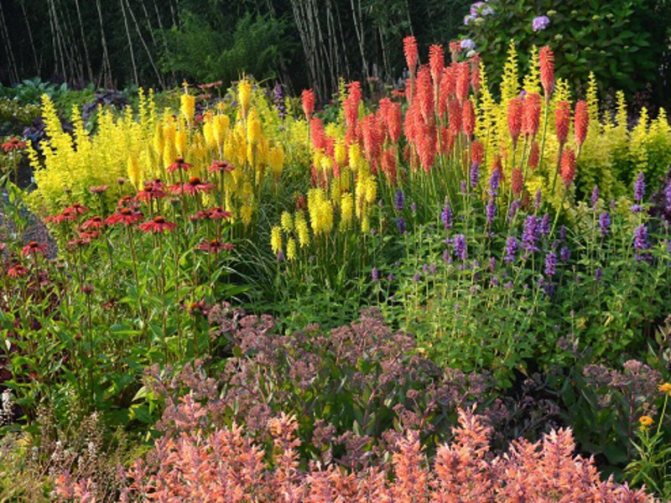

It is best to plant knifofia in places open to sunlight and near water bodies.
Due to the fact that knifofia is a rather tall plant, it is better to use it in the middle of flower arrangements. And the brightness of the coloring of this African exotic recommends a competent approach to the formation of a flower bed - it is better to place squat representatives of flora with discreet flowers and an abundance of greenery next to a perennial.
Under natural conditions of growth, knifophya gladly settles in places with high humidity - near swamps, ponds... In landscaping, you can use this natural "love" for water and plant a flower next to artificial ponds in your garden.

